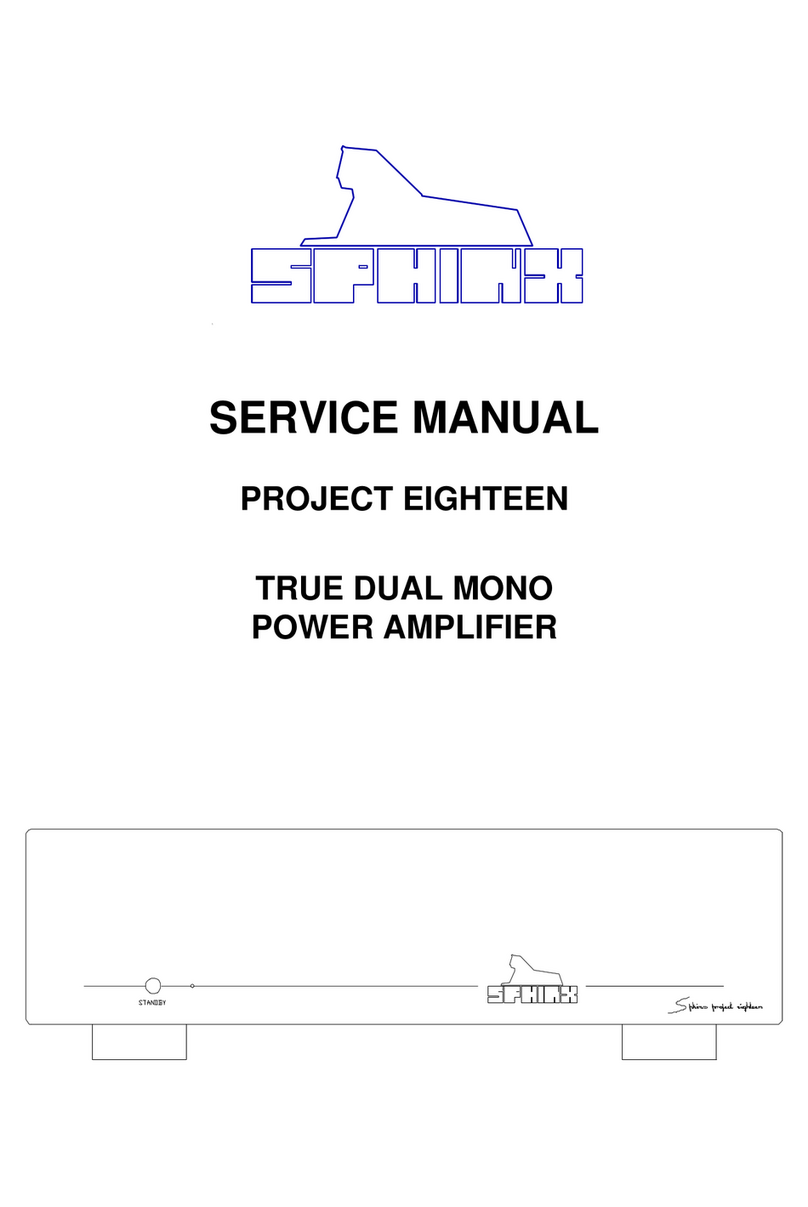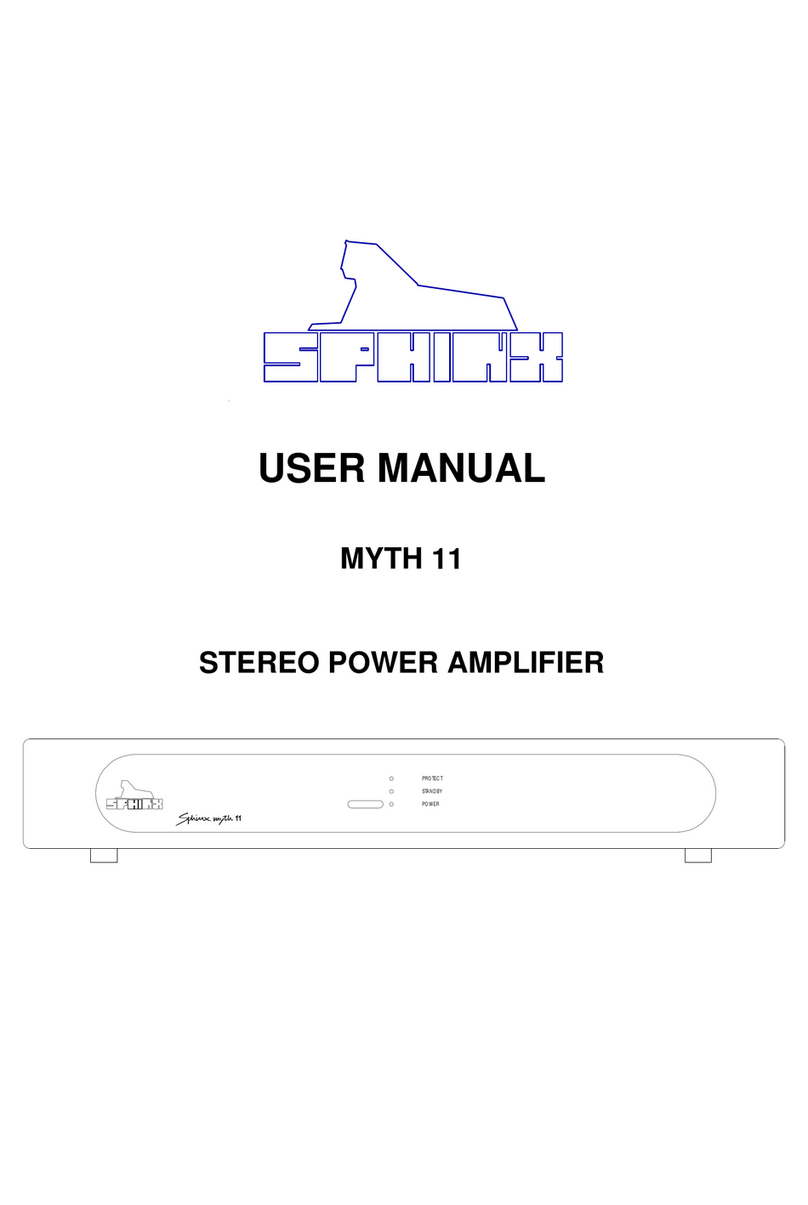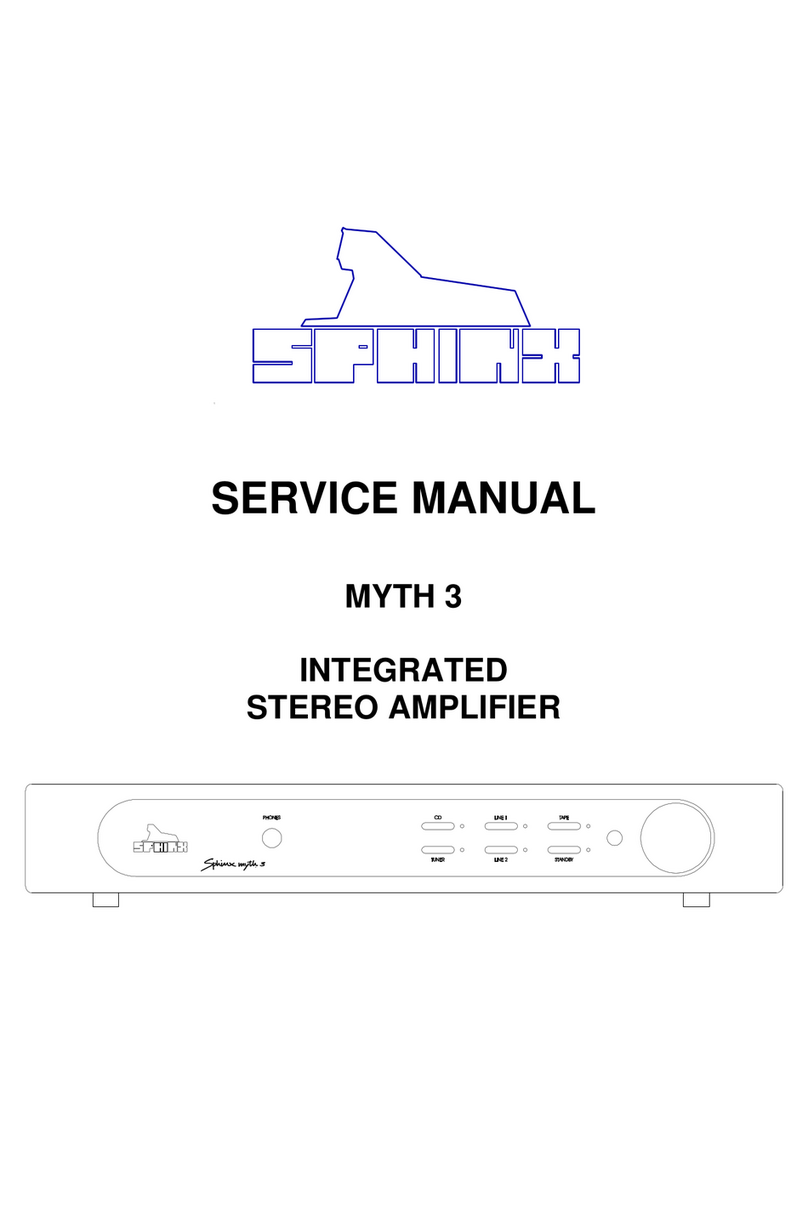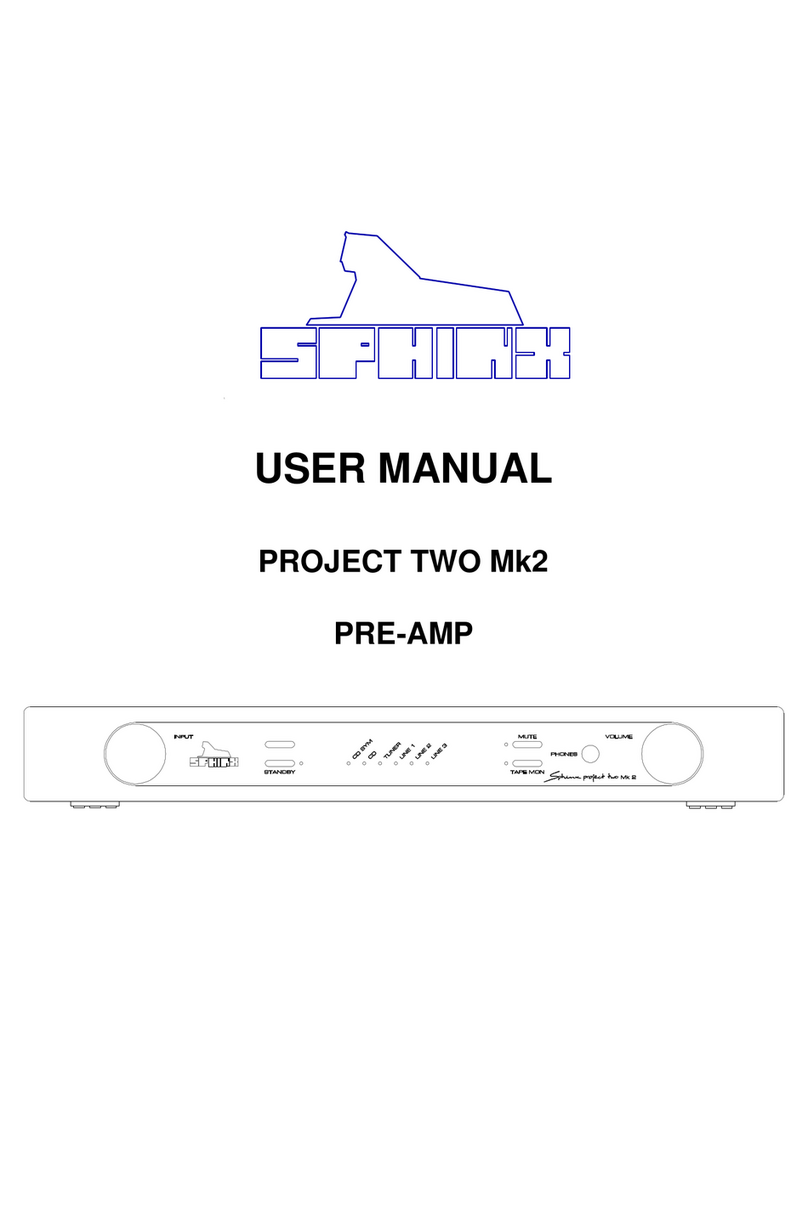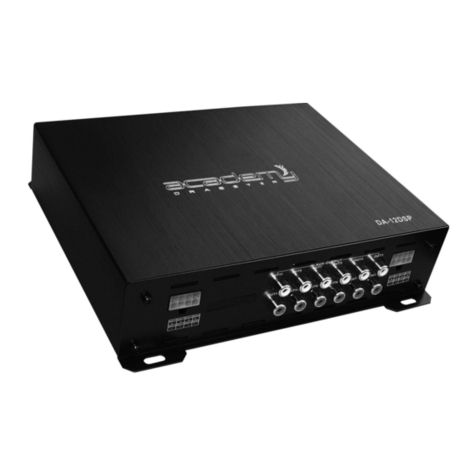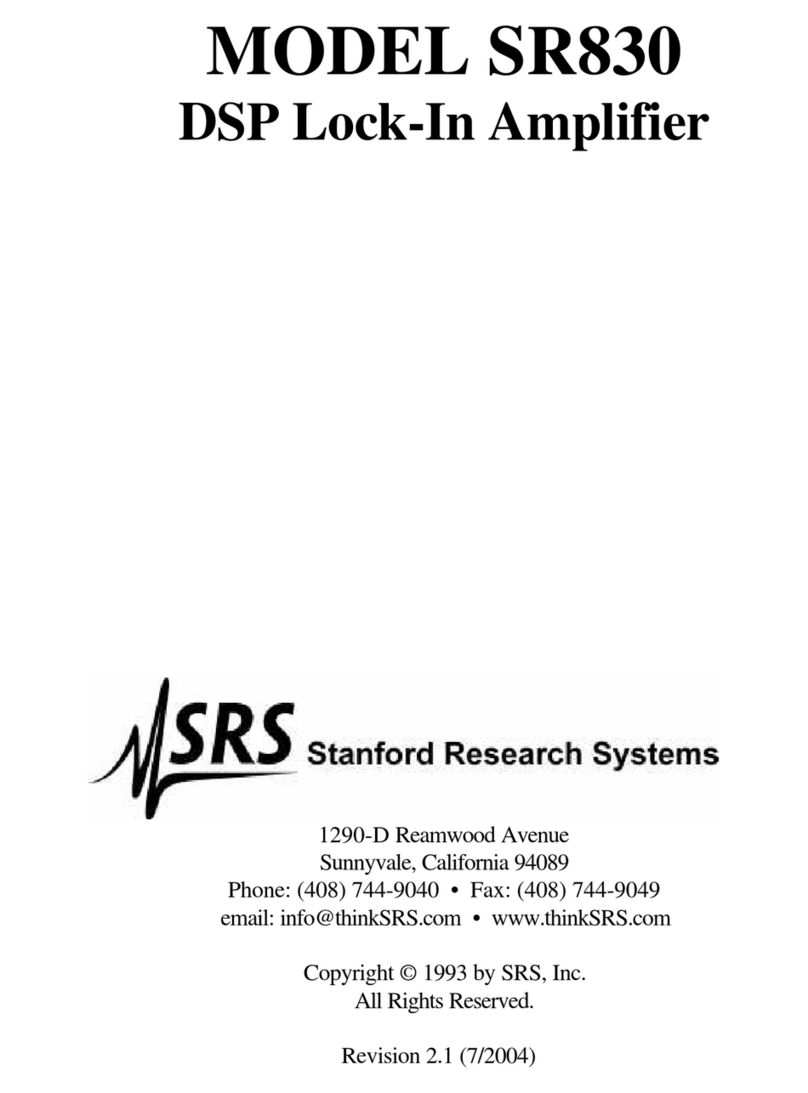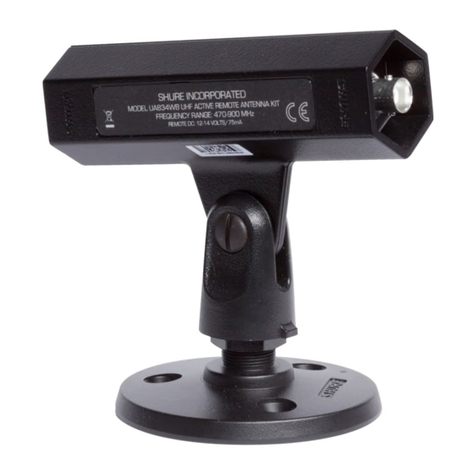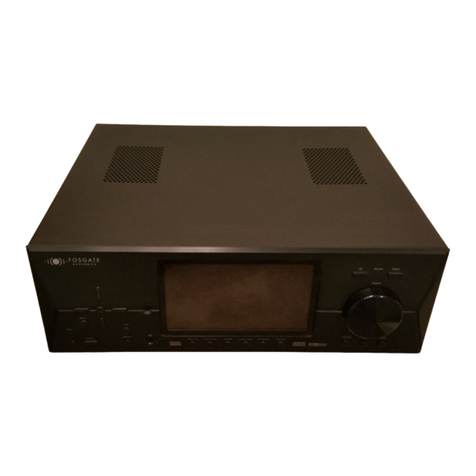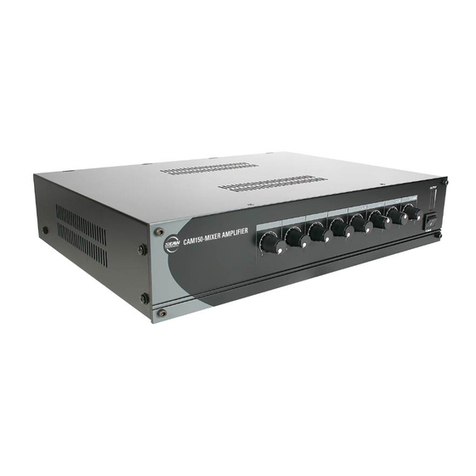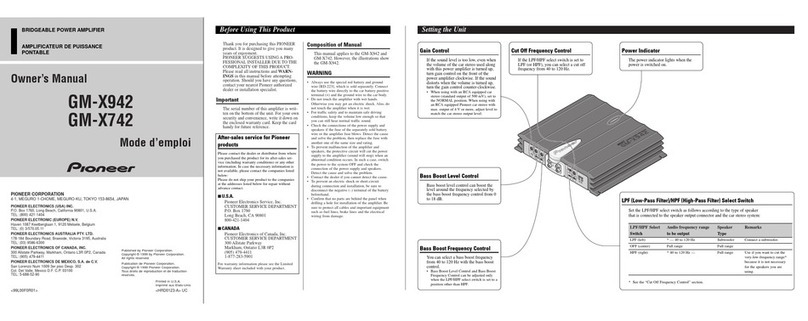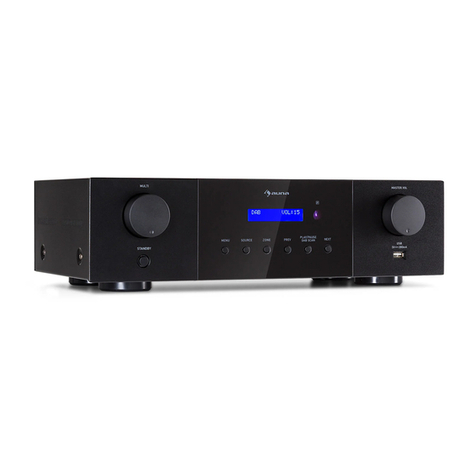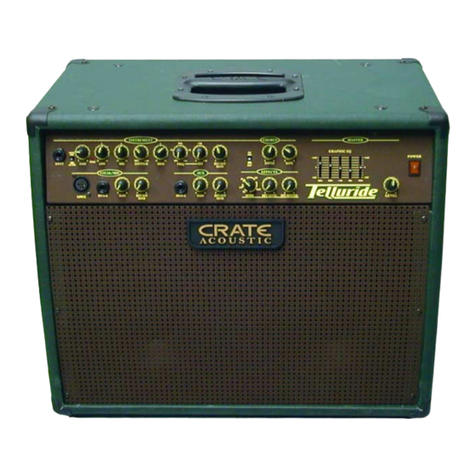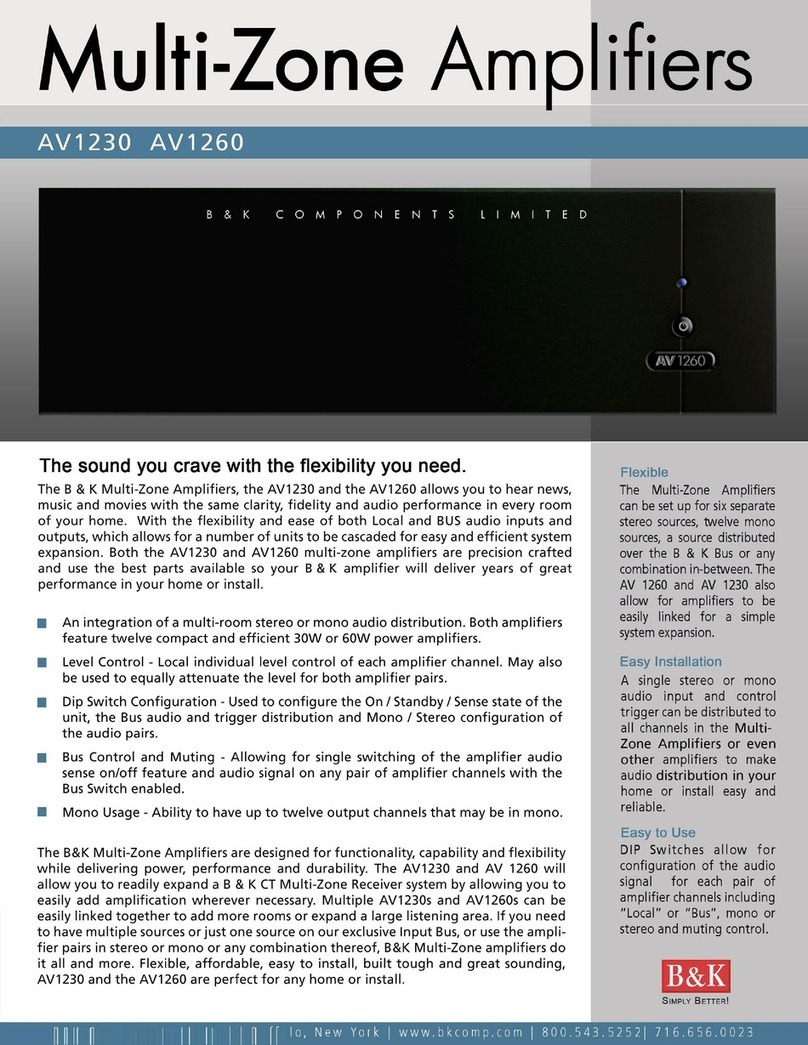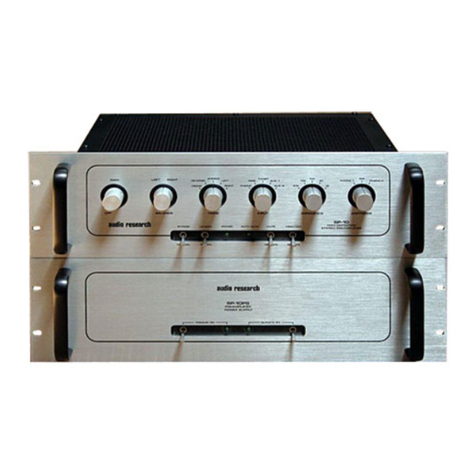SPHINX Project10 User manual

1.
SERVICE MANUAL
PROJECT TEN
INTEGRATED
STEREO AMPLIFIER

SPHINX Project Ten Service Manual
2
1. UNPACKING.......................................................................................................................................3
2. SPHINX WARRANTY CARD..............................................................................................................3
3. CONTACTING THE MANUFACTURER.............................................................................................3
4. THE AMP AT A GLANCE...................................................................................................................4
Front panel...................................................................................................................................................4
Rear panel ...................................................................................................................................................5
5. SPHINX REMOTE CONTROL............................................................................................................6
Buttons and LED indication..........................................................................................................................6
Operation.....................................................................................................................................................7
Selecting without switching..........................................................................................................................7
Batteries.......................................................................................................................................................7
Encountering problems................................................................................................................................7
6. TECHNICAL SPECIFICATIONS.........................................................................................................8
7. GENERAL CHECKLIST .....................................................................................................................9
Protection modes.........................................................................................................................................9
Short Circuit.............................................................................................................................................9
Standby mode..............................................................................................................................................9
Necessary Equipment..................................................................................................................................9
8. ADJUSTMENT PROCEDURES........................................................................................................10
Bias............................................................................................................................................................10
Offset .........................................................................................................................................................11
9. PROBLEMS AND SOLUTIONS .......................................................................................................12
10. DIAGRAMS AND PARTS LISTS....................................................................................................13
Connection diagram bias adjustment.........................................................................................................14
Connection diagram offset adjustment.......................................................................................................15
Connections main board and display board of Project 10..........................................................................16
General overview Project 10......................................................................................................................17
Project 10 power supply and input selection..............................................................................................18
Project 10 volume board............................................................................................................................19
Project 10 amplifier left ..............................................................................................................................20
Project 10 amplifier right ............................................................................................................................21
Project 10 control.......................................................................................................................................22
PCB drawings of Project 10.......................................................................................................................23
Parts list.....................................................................................................................................................24

SPHINX Project Ten Service Manual
3
The Sphinx Project Ten design
The Sphinx Project Ten was designed for the ever-
increasing group of quality-conscious audiophiles.
We are very proud of the tradition connected with
the SPHINX name, especially concerning audio
quality perfection.
This service manual will help you to optimally
service and repair the Sphinx Project Ten
Integrated Stereo Amplifier
This integrated high-end stereo amplifier is of
exceptional quality. With exception of the balanced
input section, it is of discrete design throughout (no
IC's are used). The pre-amp section is built around
Dual FET's and the amplifier is DC-coupled from
input to output.
The two mono power amps (each channel is totally
independent) use special power transistors with a
power bandwidth of over 20 MHz, a very fast slew
rate and an unsurpassed phase linearity over the
power bandwidth. The amplifiers are therefore very
stable and can effortlessly drive every type and
format of loudspeaker (even the most complex ones
such as electrostatic and magnetostatic...) at
maximum quality.
All internal audio cabling is Siltech pure silver and
the amp outputs are sent to the loudspeaker
connectors via heavy duty, completely sealed gold-
plated relays.
To obtain the maximum quality from this integrated
amp it is necessary for it to be properly aligned and
to be used with top quality audio components,
preferably other Sphinx components.
1. UNPACKING
Before leaving the factory every Project Ten is
subjected to stringent and extensive technical and
exterior quality inspection. This ensures the user
many years of high quality audio from a perfect-
looking product.
We recommend owners to ship the Project Ten in
its original carton.
After unpacking the Project Ten we therefore
recommend you carefully check it for any transport
damage.
If you find any damage and the product has not
been shipped in the original carton the ensuring
repair costs will not be covered by the warranty.
2. SPHINX WARRANTY CARD
To be entitled to any warranty repairs the owner
must have send the filled out warranty card to
Sphinx or a distributor where it has been registered.
Other regulations may apply in your specific
country: when in doubt, please consult the proper
authorities.
3. CONTACTING THE MANUFACTURER
In case of any problem not covered in this manual
or if you have other questions you may contact the
Sphinx International Service Department in The
Netherlands (local time: GMT +1h) during office
hours at the following numbers:
Telephone (+31) 35 602 0302
Fax (+31) 35 602 2806
E-mail [email protected]
It is always very helpful and efficient if you have all
relevant information about the specific product and
the problem ready.
Please also refer to the User Manual of the
Project Ten for information about functions
not described in this manual.
It is important to familiarise yourself with the
special functions, operation and possibilities
of the Sphinx Project Ten.

SPHINX Project Ten Service Manual
4
4. THE AMP AT A GLANCE
Front panel
1. VOLUME: With this motor-controlled knob you
may adjust the volume of the loudspeakers.
The volume can be controlled manually or via the
optional Remote Control.
2. STANDBY: To switch the component on and off.
When the component is 'off' (standby) this is
indicated by the red LED.
When the component is active the LED will be
green.
3. MUTE: Press this button to temporarily mute the
sound. The red LED will light.
4. CD: To select the CD input.
5. TUNER: To select the TUNER input.
6. LINE 1: To select the LINE 1 input.
7. LINE 2: To select the LINE 2 input (cinch or
balanced).
8. TAPE MON: To select the TAPE IN input.
As soon as you have pressed one of the buttons
5. to 9. the corresponding red LED next to it will
light.
9. PHONES: To connect dynamic stereo
headphones.
1
23
4
5
6
9
7
8

SPHINX Project Ten Service Manual
5
Rear panel
11. ON/OFF: This is the mains power switch.
12. Fuse holder: Contains a fuse (3.15 A slow).
13. AC Power: Connect the mains cable to a mains
power outlet (230 - 240 VAC).
14. CONTROL OUT:To connect the optical cable
going to another Sphinx component.
15. RIGHT OUTPUT:To connect the cable from the
right loudspeaker:
red +
white -
16. LEFT OUTPUT:To connect the cable from the
left loudspeaker:
red +
white -
17. Manufacturer's label: This shows important
data for the component, such as serial number
and mains power voltage.
18. BALANCED LINE 2 RIGHT:To connect the
XLR signal cable (balanced cable) from the right
output of the signal source for Input 2.
19. BALANCED LINE 2 LEFT: To connect the XLR
signal cable (balanced cable) from the left
output of the signal source for Input 2.
20. CINCH/BALANCED: This switch is to select the
input connector for LINE 2:
out LINE 2 (cinch)
in BALANCED LINE 2
21. LINE 2: To connect the cinch signal cable from
the signal source for LINE 2.
22. LINE 1: To connect the cinch signal cable from
the signal source for LINE 1.
23. TUNER: To connect the cinch signal cable from
the tuner.
24. CD: To connect the cinch signal cable from the
CD player.
25. TAPE IN: Connect this input to the output of the
recorder.
26. TAPE OUT:Connect this output to the Input of
the recorder..
11
12
13
14
15 16 17 18 19
20
21 22 23 24 25 26

SPHINX Project Ten Service Manual
6
5. SPHINX REMOTE CONTROL
This single Sphinx Remote Control lets you control
all functions: not only of the Project Ten, but of all
other Sphinx equipment.
Only the following buttons and indications on the
Remote apply to the Project Ten (the others will not
function):
Buttons and LED indication
1. PRE-AMP: To select the amp. All buttons
pressed hereafter will only control the amp
functions.
The buttons TUNER and CD will have no effect
on the amp.
2. STANDBY: Use this red button to switch the
Project Ten to stand-by.
3. : Pressing this green button mutes the
outputs (temporarily) and you will not hear any
sound. The red LED will be illuminated. Another
press on this button un-mutes the outputs
4. TAPE/MONITOR: Use this button to select the
Tape IN input. Pressing this button has the
same effect as pressing the TAPE button on the
front panel.
Note: The LED of the selected input (see 5.) will
remain illuminated.
5. 1 - 4: To select inputs CD to Line 2 .
1CD
2Tuner
3Line1
4Line 2
6. ñbutton: Pressing this button has the same
effect as clockwise rotating the VOLUME control
on the front panel. You will increase the volume.
7. òbutton: Pressing this button has the same
effect as anti-clockwise rotating the VOLUME
control on the front panel. You will decrease the
volume.

SPHINX Project Ten Service Manual
7
Operation
The Sphinx Remote is used for several different
models and can therefore transmit different control
codes, depending on which model has been
selected with the select buttons (1.).
Important: Always press the PRE-AMP button
before you send a command (even if you only have
one Sphinx component).
If not it is possible that although the Remote will
send a signal (LED blinks) nothing happens
because the transmitted signal is not 'recognised' by
the component.
Indoors the Remote may be used up to a distance
of 7 meter, provided there is no strong sunlight in
the room and if you aim the Remote at the
component.
Always aim the Remote straight at the front panel of
the component, the maximum offset angle is 30°.
Selecting without switching
Suppose for instance that you would like to select
the Tuner to Radio 4 without interrupting the CD
playback.
In that case you momentarily depress (not longer
than 0.5 sec) the 'TUNER' button and the '4' button.
The same procedure is used for the other system
components
How to operate the Remote Control with the
different Sphinx components will be explained in the
corresponding User Manual of each component.
Batteries
The four batteries have a life span of approx. one
year during normal use, but shorter when used
more intensely.
Replacement batteries: 1.5 V, model penlight or
AAA . You may also use rechargeable 1.5 V
batteries.
Note: Position the new batteries exactly as shown in
the illustration at the bottom of the battery
compartment, otherwise the Remote will not
function!
Encountering problems...
Remote Control does not work
Wrong component selected Select the correct one
Distance to component exceeds 7
mUse remote at closer
range
Angle between Remote and
component exceeds ±30° Decrease angle
Sensor window on front dirty Clean window
Batteries empty or incorrectly
placed Use new batteries or
replace the old ones
correctly
Strong (sun)light in room Shade off
Component is not switched on (!) Switch it on
Component reacts differently than expected or
not at all
Wrong component selected Select the correct one
Component or remote does not
function Check component
with it's original
remote
Batteries of remote empty Use new batteries

SPHINX Project Ten Service Manual
8
6. TECHNICAL SPECIFICATIONS
Bandwidth 0 - 60,000 Hz (+0/-3 dB with RF input filter)
Phase response error <15° (from 0 - 20,000 Hz)
Gain 21 dB max.
Minimum Power Output (1 - 20.000 Hz) >2x 80 W into 8 Ω (19.0 dBW), THD <0.01%
>2x 120 W into 4 Ω(20.8 dBW), THD <0.02%
>2x 160 W into 2 Ω(22.0 dBW), THD <0.02%
Output voltage / current, max. 34 V / 20 A
THD+N (IHF-A) <0.01% (80 W into 8 Ω)
IMD <0.03%
S/N ratio (IHF-A) >106 dB
Channel separation >80 dB (1 - 20,000 Hz)
Slew rate >25 V/µs
Damping factor >200 (1 - 20,000 Hz)
Inputs
XLR, balanced
cinch, unbalanced 1x Line 2
1x Line 2, 1x Line 1, 1x CD, 1x Tuner, 1x Tape
level, nominal 0.15 V (-16.5 dBV) for 60 W into 8 Ω
impedance 20 kΩ(3 kΩbalanced)
Outputs
cinch 1x Tape
level 10 V max. (20 dBV) (1 - 20,000 Hz, THD <0.01%)
headphones 1x 6.3 mm stereo jack, adjustable level
clamp 1x loudspeaker L, 1x loudspeaker R
Supply capacitance 54,400 µF per channel
Power consumption 480 W max. (57.5 W standby)
Dimensions (h x w x d) 110 x 482 x 330 mm
Weight 12 kg
This unit conforms to the EMC interference regulations from the EU and to the CE standards.
This unit complies with safety regulation VDE 0860 and thus with international safety regulation IEC 65.
Technical specifications can be changed by SPHINX without prior notice if technical developments make this
necessary.
©1998 Audioscript BV

SPHINX Project Ten Service Manual
9
7. GENERAL CHECKLIST
Before you test or service the Project Ten please
check the following items. They will give information
about the current status of the amplifier.
Protection modes
The Project Ten has one protection mode.
Short Circuit
If the Left or Right output is shorted, fuse Z1 or Z2
will blow respectively.
Standby mode
The Project Ten will switch to Standby Mode if the:
•Standby button on the front panel or
•Standby button on the Remote is pressed.
In this Mode the following will happen:
•The output relay is switched off.
•The Control Output will be activated (red light).
•The bias current for the Left and Right amplifiers
is reduced to 0 mA thus greatly decreasing the
operating temperature.
Necessary Equipment
To properly service the Project Ten you need some
specific measurement equipment and use a specific
set-up.
For the correct measurement set-up and hook-up
please refer to the drawing titled “Connection
Connection diagram… at pages 14 and 15.
q2x millivolt-meter (Ri >1 MΩ)
q2x non-inductive load resistor 8 Ω/ 100 Watt
q1x harmonic distortion analyser
(internal distortion <0.0005%, measured
without filters)
q1x 2-channel oscilloscope
(minimum bandwidth >60 MHz)
q1x connection unit / switch box
(to connect scope, resistors and amp outputs to
distortion analyser)
q2x shorting connector
(for balanced pre-amp inputs)
q2x balanced cable set
(to connect distortion analyser to Project Ten)

SPHINX Project Ten Service Manual
10
8. ADJUSTMENT PROCEDURES
The Project Ten is an integrated amplifier, meaning
the pre-amp and power amp sections are combined
into one cabinet.
The Project Ten only has two parameters for each
channel (so four in total) that might need
adjustment:
-Bias: to set the bias current and bias voltage of
the amplifier for normal use.
-Offset: to set the DC-offset voltage of the
output.
These adjustments might be necessary when the
amplifier has been used for a period of time (and
settings have changed due to ageing) or when a
part of the Project Ten have been replaced.
Attention:
When re-adjusting any setting please ensure that
there is no loudspeaker connected to the output!
Otherwise the loudspeaker may be seriously
damaged.
Attention:
The amplifier is able to generate high output
voltages of over + or -40 V.
Please be very careful during the adjustments!
The Project Ten is a two channel amplifier.
After removing the top cover plate you will see the
Left and Right Channels clearly marked.
The power transistors are mounted underneath the
heatsinks.
Bias
With this procedure you set the proper bias level for
the power transistors. This ensures their Class A
operation at low power levels.
Connect the amplifier according to the drawing
“Connection Diagram Bias Adjustment” (page 14).
The input of the amplifier must be shorted (by way
of the MUTE function of the oscillator).
•Switch the amplifier ON and wait until it has
reached the proper working temperature (this
takes an hour).
•Set the millivolt-meter to the DC-range.
•Place the two measuring clips of the meter
across one of the emitter resistors
Left: R267, R271, R273, R277
Right: R467, R471, R473, R477
(refer to schematic in Pj10main.PDF).
These resistors are positioned to the left of the
power supply condensers.
•The level for each should be 40 mV DC
(±2 mV).
If not: adjust potmeter P202 (Left) or potmeter
P402 (Right) until the level is 40 mV.
•Switch the oscillator on and set it to 1 kHz and a
level of 0 dBu.
•Check the distortion with a THD analyser: it
should be conform the specified values (0.01%
IHF-A @ 1 – 20 kHz @ 80 W into 8 ohm).
•If this is correct the procedure is finished.
•You may now switch off the amplifier or continue
with another adjustment procedure.

SPHINX Project Ten Service Manual
11
Offset
The Offset adjustment procedure minimises the DC
offset value of the amplifier output. This DC offset is
important when capacitive loads are used, such as
electrostatic loudspeakers. These loudspeakers
often use a very low-impedance step-up
transformer. The amplifier ‘sees’ this load as a
short for the DC voltage.
Connect the amplifier according to the drawing
“Connection Diagram Offset Adjustment” (page 15).
The input of the amplifier must be shorted (by way
of the MUTE function of the oscillator)..
•Switch the amplifier ON and wait until it has
reached the proper working temperature (this
takes an hour).
•Set the millivolt-meter to the DC-range.
•Place the measurement clips of the meter over
the output terminal.
•The level should not exceed +5 or -5 mV DC.
If not: adjust potmeter P201 (Left) or P401
(Right) until the level is within this range.
•Switch the oscillator on and set it to 1 kHz and a
level of 0 dBu.
•Check the distortion with a THD analyser: it
should be conform the specified values (0.01%
IHF-A @ 1 - 20 kHz).
•If this is correct the procedure is finished.
•You may now switch off the amplifier or continue
with another adjustment procedure.
Attention:
Do not connect speakers on the Project 10 when
adjusting the offset.
Please be careful during the adjustments!

SPHINX Project Ten Service Manual
12
9. PROBLEMS AND SOLUTIONS
At the moment of writing the Project Ten has no
known specific problems.
If in the future you encounter any problem(s) you
may enter the info in this table. This table can then
be used for future reference.
Please also send (by fax or e-mail) the specific
information to the Sphinx International Service
Department (see page 3): this info can then be
added to the general database to aid others.
Problem Cause Solution Refer to
page…
Amplifier doesn’t work Fuses are blowed (short circuit
output) Replace fuses type 3.15A SB Page 18

SPHINX Project Ten Service Manual
13
10. DIAGRAMS AND PARTS LISTS
The next pages contain the front and rear panel lay-out and a complete set of schematic drawings including the
associated parts lists (if applicable).
Connection diagram bias adjustment .........................................................................................................14
Connection diagram offset adjustment.......................................................................................................15
Connections main board and display board of Project 10 ..........................................................................16
General overview Project 10 ......................................................................................................................17
Project 10 power supply and input selection ..............................................................................................18
Project 10 volume board.............................................................................................................................19
Project 10 amplifier left...............................................................................................................................20
Project 10 amplifier right.............................................................................................................................21
Project 10 control .......................................................................................................................................22
PCB drawings of Project 10........................................................................................................................23
Part list .......................................................................................................................................................24

SPHINX Project Ten Service Manual
14
Connection diagram bias adjustment
out1 out2
inp2
inp1
gnd
THD Amplitude
Frequency
Oscillator
THD out
(+) (-) (+) (-)
THD ANALYZER
out1 out2
inp2inp1
Scoop
SWITCH-BOX
Right
Left (+)
(+)
(-)
(-)
Amplfier (30x)
A
B
Project 10
GND

SPHINX Project Ten Service Manual
15
Connection diagram offset adjustment
out1 out2
inp2
inp1
gnd
THD Amplitude
Frequency
Oscillator
THD out
(+) (-) (+) (-)
THD ANALYZER
out1 out2
inp2inp1
Scoop
SWITCH-BOX
Right
Left (+)
(+)
(-)
(-)
Amplfier (30x)
A
B
Project 10
GND
mVmV
GND

SPHINX Project Ten Service Manual
16
Connections main board and display board of Project 10
+12V
+5V
GND
L2
L1
TU
CD
TM
TS
STB
VOL1
VOL2
MU
12V-SW
IN-L
IN-R
PRE-L
PRE-R
+12V
+5V
GND
L2
L1
TU
CD
TM
TS
STB
VOL1
VOL2
MU
12V-SW
IN-L
IN-R
PRE-L
PRE-R
+12V
+5V
GND
L1
L2
TU
CD
TM
TS
STB
MU
VOL1
VOL2
12V-SW
+12V
+5V
GND
L1
L2
TU
CD
TM
TS
STB
MU
VOL1
VOL2
12V-SW
PJ10 main board PJ10 control board
IN-L
IN-R
PRE-L
PRE-R
GND
VOL1
VOL2
IN-L
IN-R
PRE-L
PRE-R
GND
VOL1
VOL2
PJ10 volume board
IN-L
IN-R
PRE-L
PRE-R
GND
+12V
+5V
GND
L1
L2
TU
CD
TM
TS
STB
MU
VOL1
VOL2
+12V
+5V
GND
L1
L2
TU
CD
TM
TS
STB
MU
VOL1
VOL2
12V-SW 12V-SW
VOL1
VOL2
GND
FUSE
MAINS SWITCH
MAINS FILTER
TRANSFORMER
CN103 (RED)
CN104 (YELLOW)
CN105 (BLUE)
CN106 (GRAY)
CN107 (GREEN)
CN108 (PURPLE)
MAINS INLET 33V
33V
14V
IN-L
IN-R
PRE-L
PRE-R
PURPLE
ORANGE

SPHINX Project Ten Service Manual
17
General overview Project 10
PRE-L
+44V
GND
-44V
OUT-L
-15V-L
+15V-L
PRE-L
+44V
GND
-44V
OUT-L
-15V-L
+15V-LGND
+44V
PRE-R
-44V
OUT-R
-15V
+15V
GND
+44V
PRE-R
-44V
OUT-R
-15V
+15V
+12V
+5V
+44V
GND
-44V
MUTE
STB
TM
L1
CD
L2
TU
OUT-L
OUT-R
MU
+12V
+5V
+44V
GND
-44V
MUTE
STB
TM
L1
CD
L2
TU
OUT-L
OUT-R
MU
+12V
GND
IN-L
IN-R
OUT-L
OUT-R
MUTE
-15V-L
+15V-R
-15V-R
+15V-L
+12V
GND
IN-L
IN-R
OUT-L
OUT-R
MUTE
-15V-L
+15V-R
-15V-R
+15V-L
+12V
+5V
+44V
-44V
GND
STB
PRE-L
OUT-L
PRE-R
OUT-R
-44V
GND
+44V
IN-L
IN-R
OUT-L
OUT-R
TM
CD
L1
L2
TU
+12V
GND
OUT-L
OUT-R
PJ10 left channel PJ10 right channel
PJ10 input/outputPJ10 power supply
+15V-L
-15V-L
+15V-R
-15V-R
+15V-L
-15V-L
+15V-R
-15V-R
MU
MUTE MUTE
+44V
GND
-44V

SPHINX Project Ten Service Manual
18
Project 10 power supply and input selection
Z1
3.15A
Z2
3.15A
B101
B102
+C109 +C110 +C111 +C112
+C113 +C114 +C115 +C116
GND
+44V
-44V
8 X 6800U/50V
-44V
GND
+44V
B103
R111
1R00
+C107
1000U
VoutVin
GND
Q102
7812
C108
100N
+C106
47U/25V
R103
10K0
R102
10K0
R106
10K0
R105
10K0
R108
100K R107
100K
R104
22K1
R109
47K5
R101
10K0
R110
33K2
VoutVin
GND
Q101
7805
C102
100N
+C101
C16V/1U5
T107
BC556
T101
BC546
T105
BC546
T106
BC546
T104
BC546
REL103A
TUNER REL104A
LINE1 REL105A
LINE2
D105D102 D104D103
1
2
3
4
5
6
7
8
9
10
11
12
13
14
15
16
17
18
CN102
18PIN
REL101A
TAPE-MON
D101
REL102A
CD
+C105
47U/25V
+
C104
330U/50V
+
C103
330U/50V
D106
1N4148
STB
+12V
+5V
MU
MUTE
+12V
+5V
MU
+12V
TS
GND
STB
TM
+5V
CD
+5V
TU
VOL2
L1
VOL1
L2
12V-SW
TM
CD
TU
L1
L2
12
OPTO201B
12
OPTO401B
OPTO101 R112
1K00
OUT-L
OUT-R
35V
8 X 220pF STYROFLEX
125V of 160V
op onderzijde solderen
D101 t/m D106 : 1N4148
GND
+12V
GND
+44V
+12V
+5V
GND
-44V
D107
6V8
12V-SW
CN103
CN104
CN105
CN106
CN107
CN108
T102
BD880
T103
BC517
heatsink
1
2
CN109
+5V
TS
temperature sensor (optional)
REL101B
REL102B
REL103B
REL104B
REL105B
REL101C
REL102C
REL103C
REL104C
REL105CCN112B
CN111A
CN110A
CN112A
CN111B
CN110B
R301 4K75
R501 4K75
R479
1K00
R480
1K00
R481
100R
R280
1K00
R281
100R
R279
1K00
S101A
S101B
2
36
74
1
5
IC301
SSM2143
R303
1K50 R304
1K50
R302
100R
+C302
47u
+C303
47u
C301
100n
C304
100n
GND
GND
GND
1
3
2
CN113
XLR
2
36
74
1
5
IC501
SSM2143
R503
1K50 R504
1K50
R502
100R
+C502
47u
+C503
47u
C501
100n
C504
100n
GND
GND
1
3
2
CN114
XLR
GND
REL106
MAIN-L MAIN-R
GND
D108
1N4148
+12V
MUTE
CN115
GND
OUT-L
OUT-R
to speaker terminals
+15V-R
-15V-R
+15V-R
-15V-R
GND
-15V-L
+15V-L
+15V-L
-15V-L
headphone jack
+15V-L
+15V-R
GND
-15V-L
-15V-R
+12V
+12V
IN-R
IN-L
to volume board
XLR <-> CINCH OUT-L OUT-R
OUT-R
OUT-L
MUTE
MUTE

SPHINX Project Ten Service Manual
19
Project 10 volume board
M
P801A
solderconnection on volume board
P801B
P801C
solderconnection on main board
PRE-R
PRE-L
IN-R
IN-L
GND
VOL1
VOL2

SPHINX Project Ten Service Manual
20
Project 10 amplifier left
R200
2K21
R201
47K5
R203
2K21 R205
1K50 R207
2K21
R204
1K00
R206
182R
R214
681R
R211
100R R216
100R
R202
22K1
R209
3K32
R217
10R0
R208
221R
T201
K389
T204
C2240
T202
C2240
T203
C2240
T206
C2240 T208
C2240
T209
C2240
T224
C2240
T219
C2240
T214
C2240
T215
C2240
T220
C2240T216
C2240
C201
330P
LD201
LD202
LD203
GND
T213
A970
T221
A970
T223
A970
T217
A970
T207
A970
T218
A970
T210
A970
T222
A970
T205
A970
C200
220P
C222
47P
C202
22P
GND
GND
R213
100R R215
100R
R210
10K0
R212
47K5
GND
P201
200
R218
221
R219
47R5
R220
47R5
R221
1K00
R224
10K0 C207
1N
GND
R222
10R0
R231
1K00
R226
1K00
R239
47R5
R236
47R5
R225
10K
R229
221R
R241
1K00
R237
1K00
R233
47R5
R235
1K00
R242
47R5
R232
1K00
R234
1K00
R228
10K
R238
1K00
R230
221R
R240
1K00
R223
10R0
R227
1K00
C203
100N
C204
100N
+
C205
1000U
+
C209
1000U
+C206
47U
+C210
47U
+C212
47U
+C208
47U
+C213
47U
+C211
47U
Z201
16V
LD204
Z202
16V
LD205
C214
330P
C215
330P
R246
47R5
R247
1K82
R265
47K5
T225
A1145
T226
C2705
R249
332R
LD208
LD206
D201
R250
332R
R251
3K92
R255
47R5 R252
4K75
P202
10K
+C220
10U
54
OPTO201A
SFH601-3
R243
10R
C216
33P
C217
220P
GND
LD207
LD209
R248
95K3
R271
1R0
R267
1R0
R276
10R0
R272
10R0
R275
10K0
R274
10K0
R277
1R0 R263
47R5
R258
47R5
R266
10R0
R269
10K0
R268
10K0 R270
10R0
R260
221R
R254
47R5
R264
221R
R259
221R
R256
6R81 R257
6R81
R261
6R81 R262
6R81
R253
47R5
T233
A1302
T232
A1302
T231
A1306
T229
C3298
T234
C3281
T235
C3281
T227
C3423
T228
A1360
C223
100P
C224
100P
R273
1R0
R278
15R
D202
1N5407
D203
1N5407
C221
100N
GND
GND GND
GND
GND
GNDGND
PRE-L
GND
-44V
+44V
from volume board
to output relay
+44V
-44V
GND
+15V-L
-15V-L
4W
+15V-L
-15V-L
IN-L
OUT-L
IN-L
+44V
+15V-L
GND
-15V-L
-44V
OUT-L
P201
P202
OFFSET
BIAS
POT.METER FUNCTION
OUT-L
T230
BC517
BD901
T212
BD902
This manual suits for next models
1
Table of contents
Other SPHINX Amplifier manuals
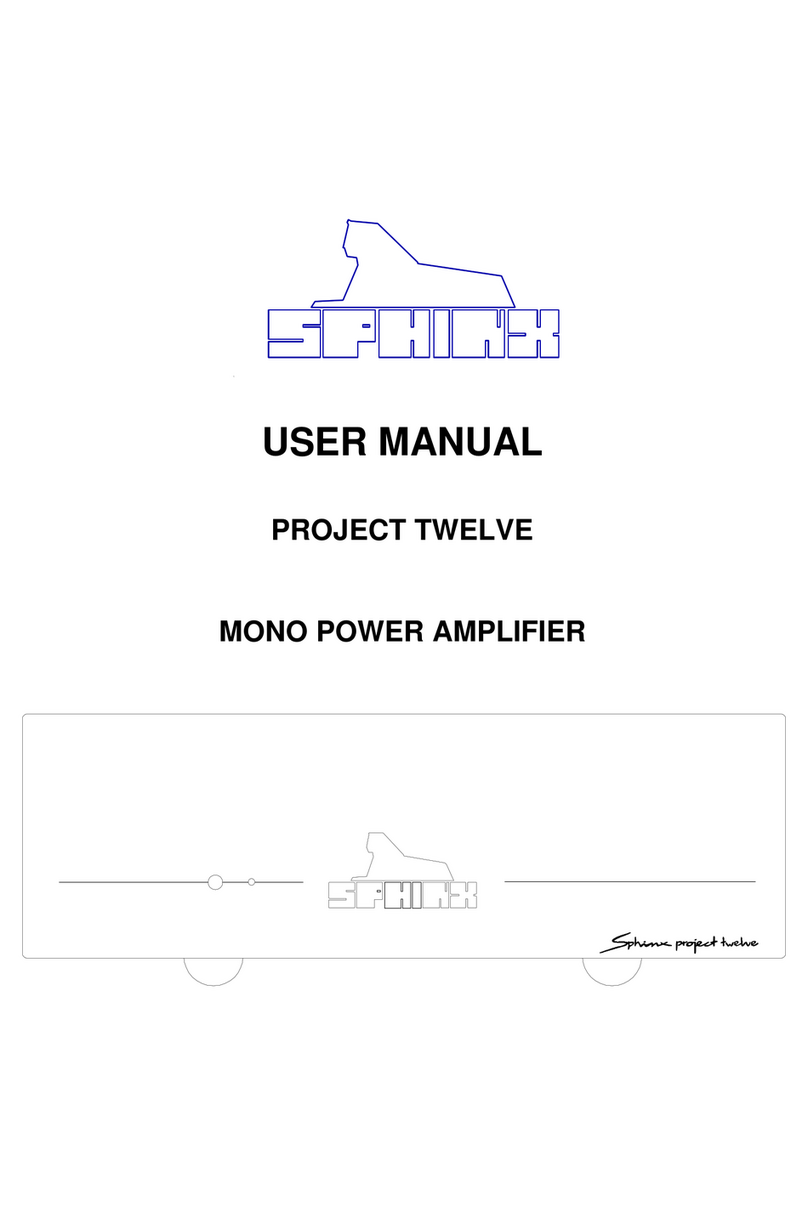
SPHINX
SPHINX Project Twelve User manual

SPHINX
SPHINX Myth 1 User manual
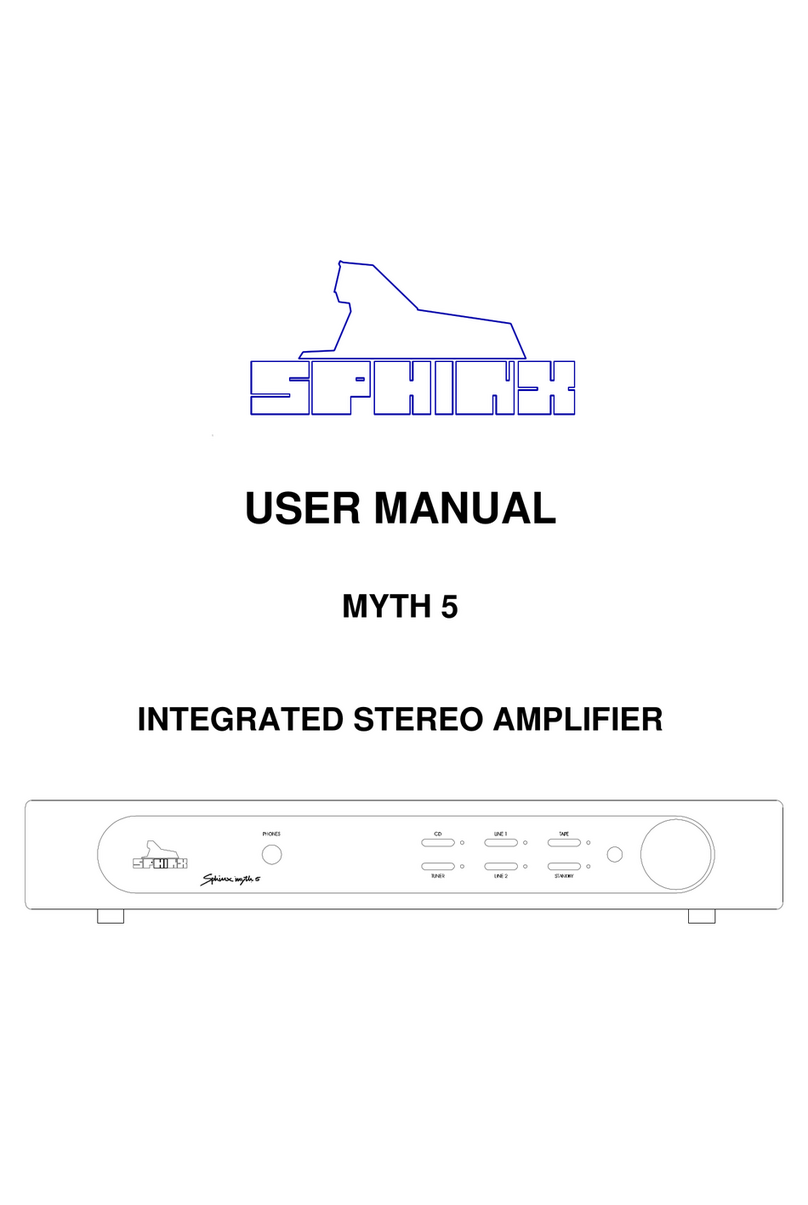
SPHINX
SPHINX MYTH 5 User manual
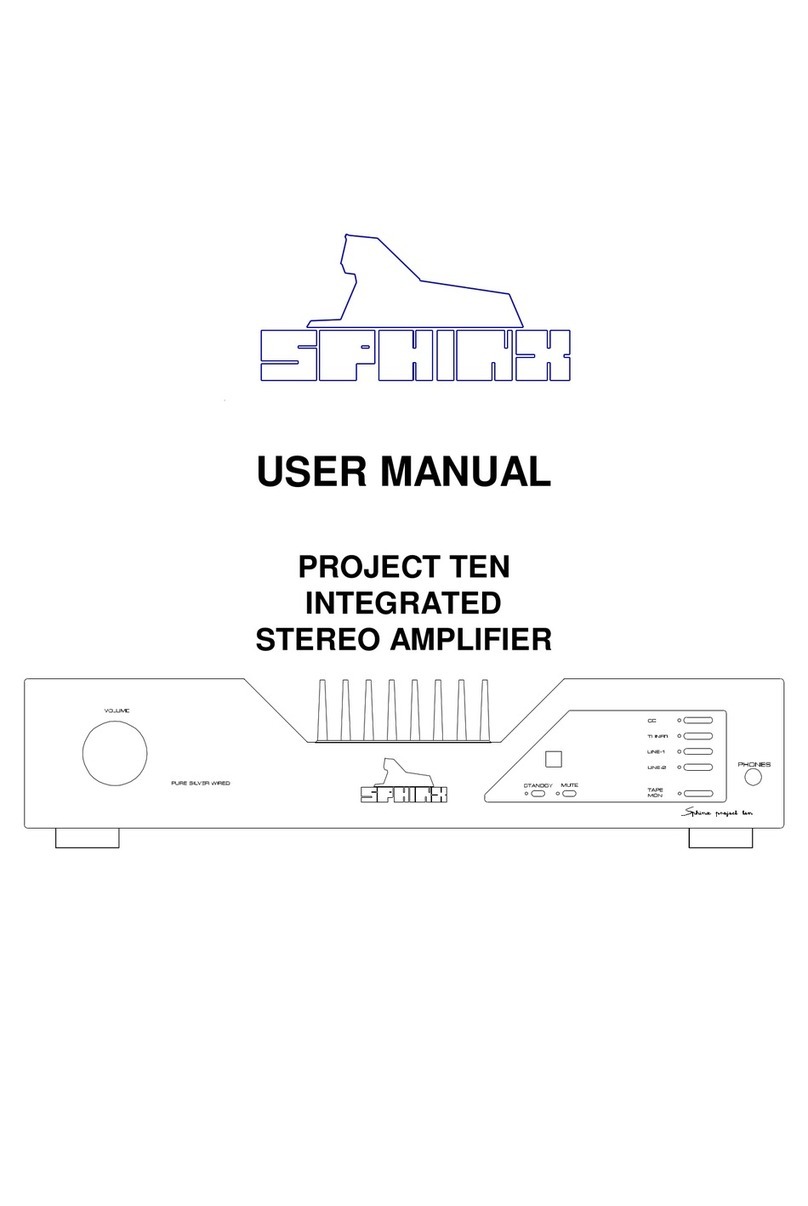
SPHINX
SPHINX PROJECT TEN User manual

SPHINX
SPHINX Project Twelve User manual
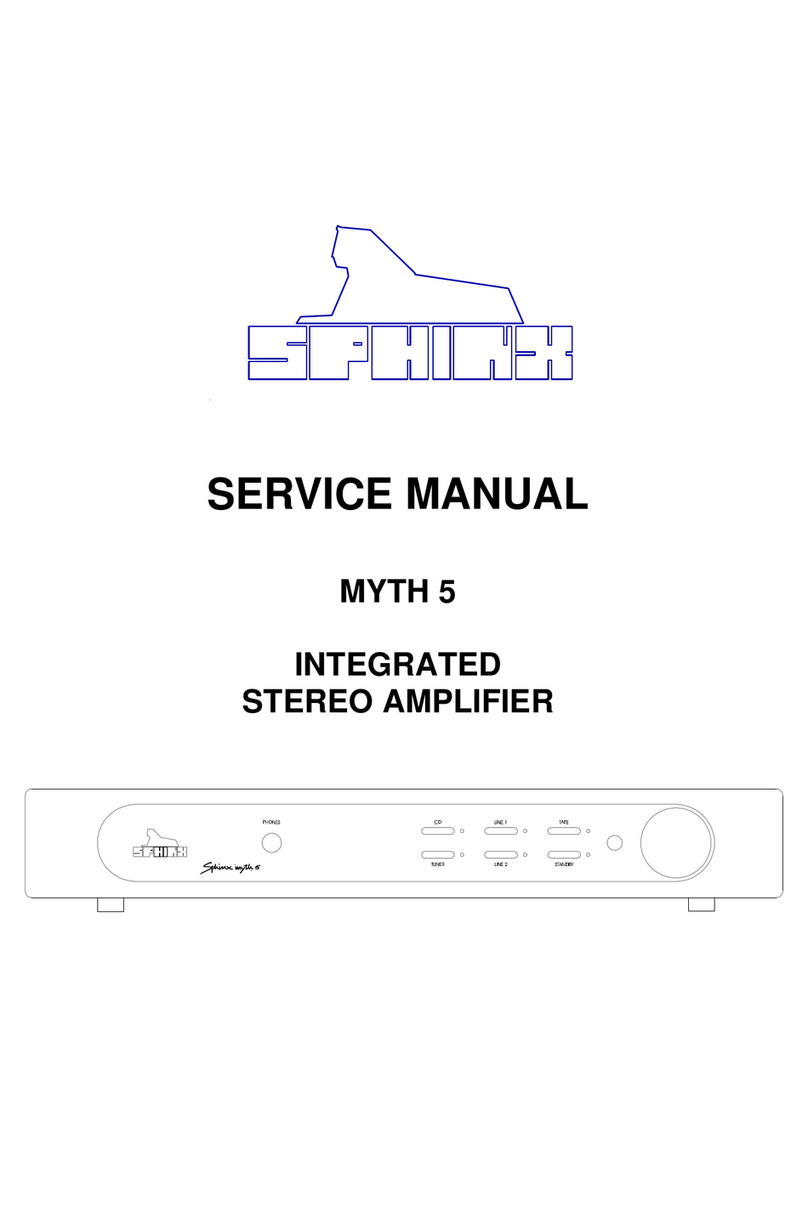
SPHINX
SPHINX Myth5 User manual
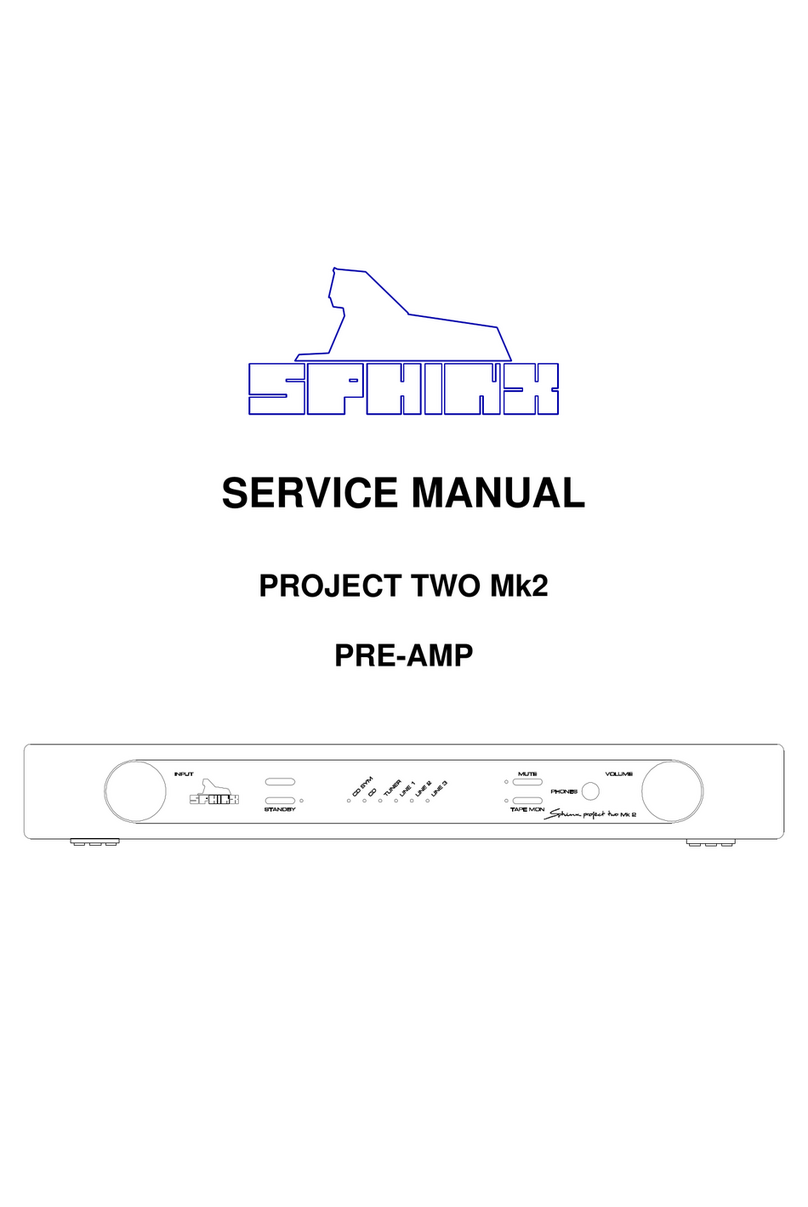
SPHINX
SPHINX Project Two MKII User manual
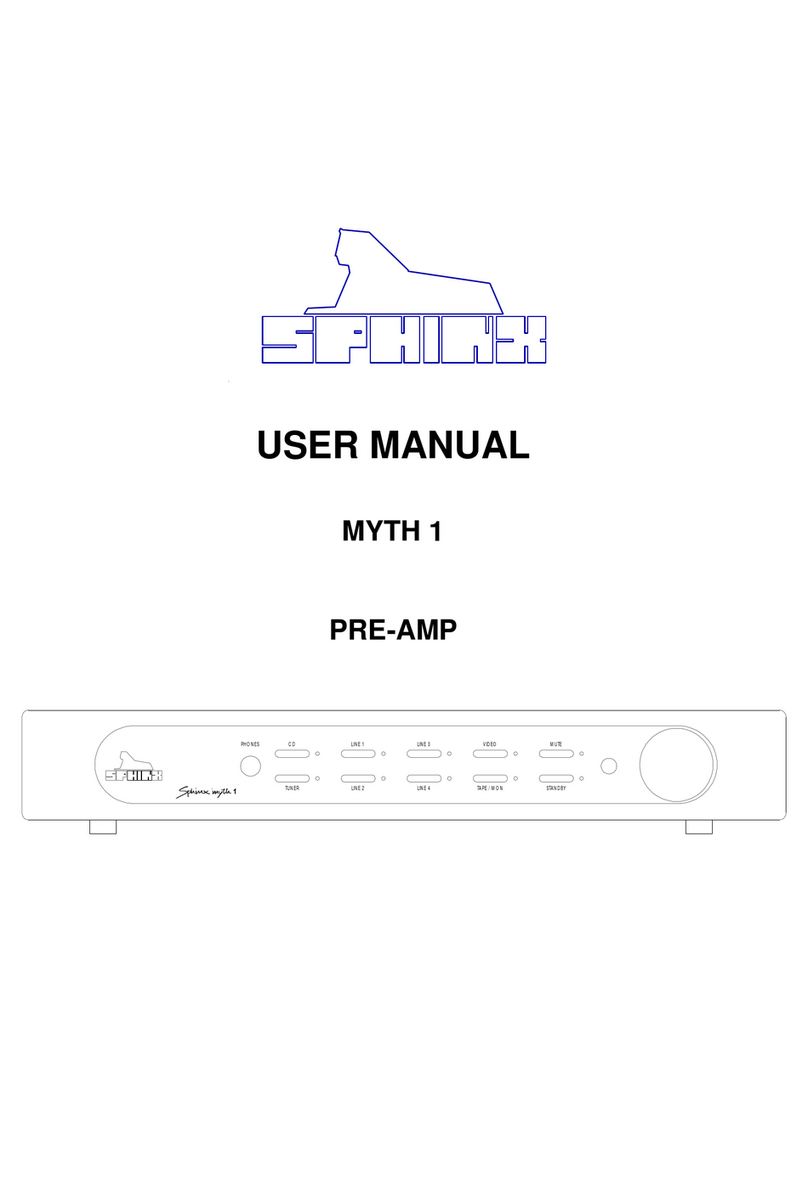
SPHINX
SPHINX Myth 1 User manual
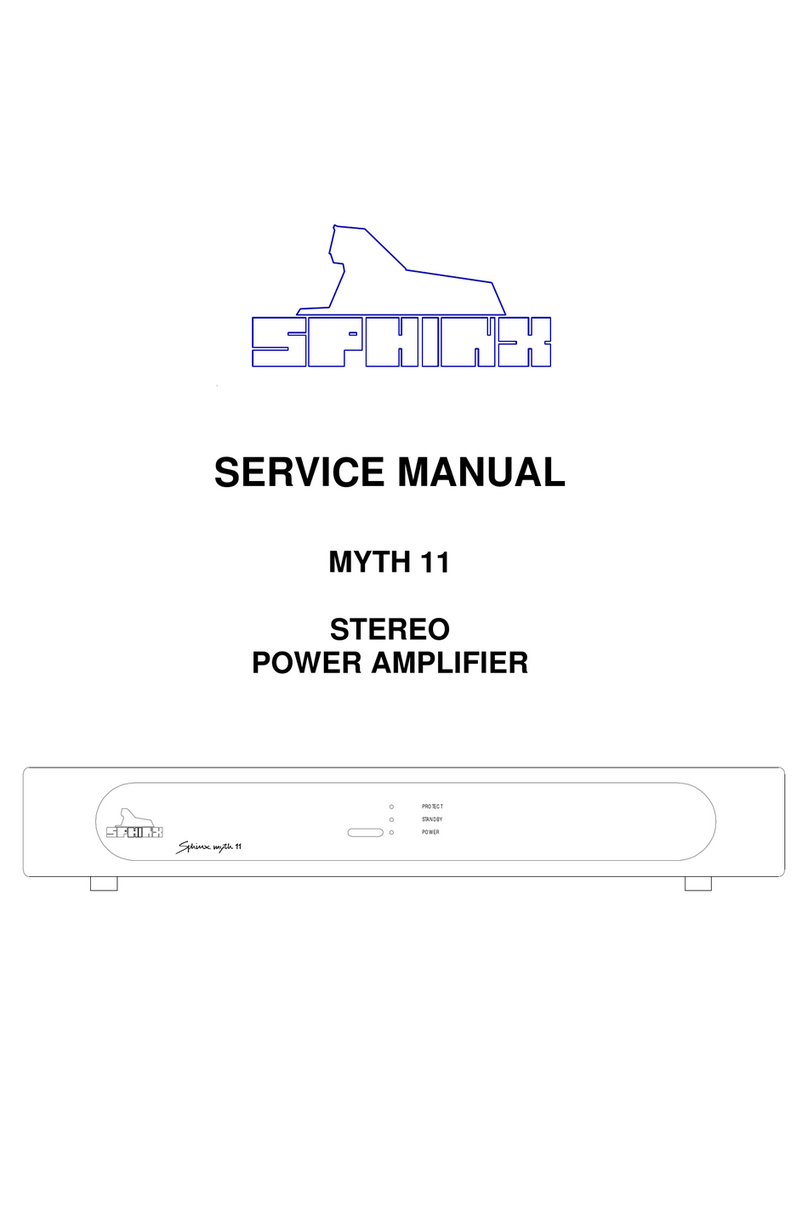
SPHINX
SPHINX Myth11 User manual
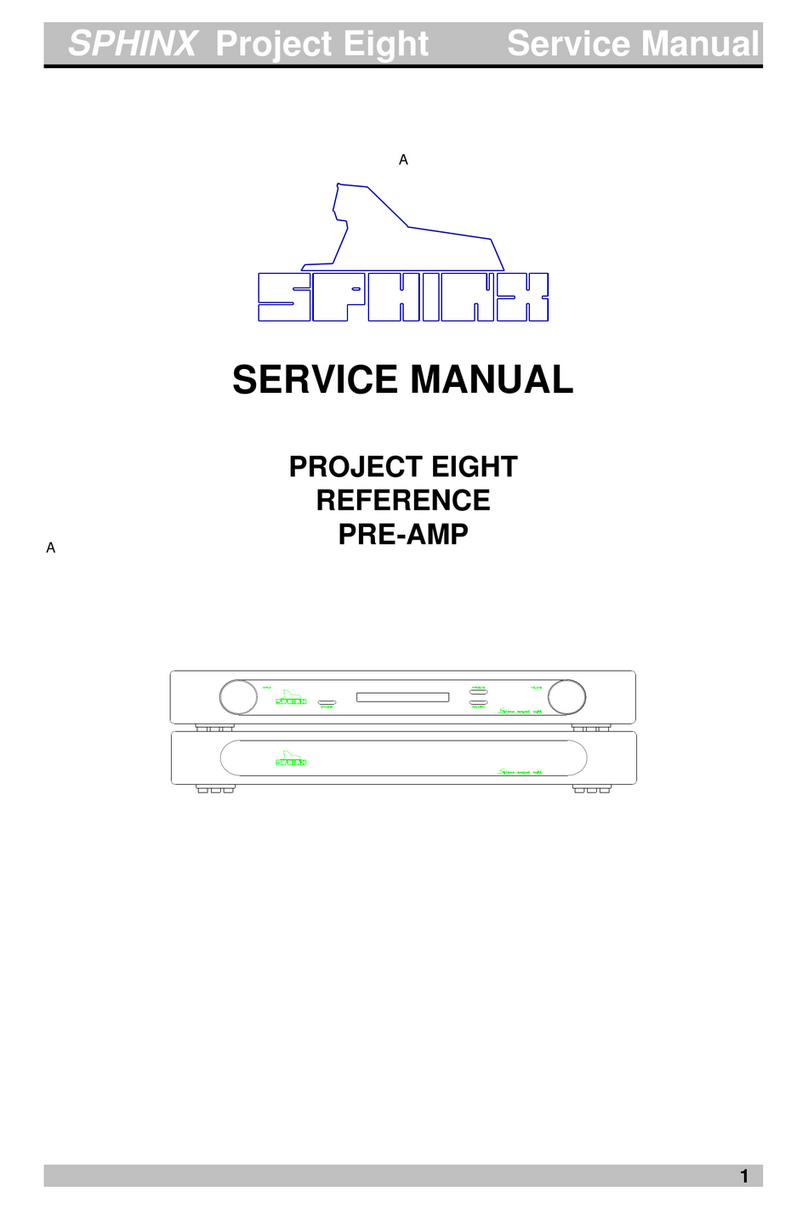
SPHINX
SPHINX Project Eight User manual
